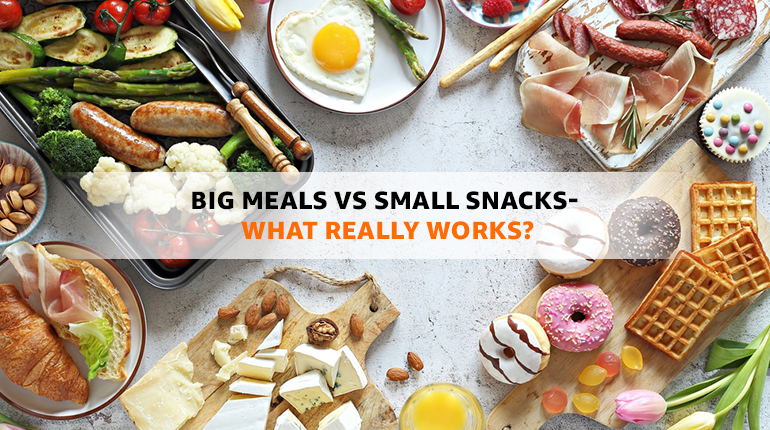Big Meals vs. Small Snacks – What Meal Plan is Best for You?

In most scenarios, the prevailing advice leans towards consuming 2-3 small meals and 2-3 snacks, translating to a meal or snack every 2-3 hours and totaling 4-6 meals per day.
While the popularity of smaller, frequent meals is on the rise, it’s essential to recognize that this eating pattern may not resonate with everyone. On the flip side, adhering to the traditional three-meals-a-day structure offers distinct advantages, particularly in managing calorie intake and fostering a prolonged sense of fullness and satisfaction.
Opting for three well-rounded meals provides a structured approach to eating, reducing the likelihood of excessive calorie consumption. This approach capitalizes on the inherent satisfaction derived from wholesome, balanced meals, promoting a sense of fullness that lingers longer after each dining experience.
Once you weave these essential variables, explained hereafter, into your dietary choices, the path becomes clearer. You’ll find it easier to decide whether to embrace hearty, substantial meals or opt for the constant nibbling approach with smaller snacks. Or perhaps, you might discover that your ideal routine involves a blend of both, or that you lean towards fewer, larger meals each day.
3 Square Meals: A Balanced Lifestyle
Research conducted by the Journal of Clinical Nutrition suggests that consuming larger meals can lead to an increased thermic effect of food (TEF). In simpler terms, your body burns more calories to digest and process a larger meal. This aids in weight management.
Moreover, a study published in the International Journal of Obesity found that individuals who consumed larger, protein-rich meals reported increased feelings of fullness and satisfaction compared to those who consumed smaller, energy-dense meals.
However, it’s essential to consider individual factors such as metabolism and personal preferences, as overeating during big meals might counteract the potential benefits.
For those leading busy lives, the prospect of planning and preparing numerous mini-meals might be impractical. In contrast, allocating time for three proper meals allows for a more deliberate and mindful approach to eating. With a plate brimming with diverse flavors and essential nutrients, these meals become opportunities to savor and appreciate the culinary experience.
At the end of the day, it’s okay to enjoy a cheat day every once in a while; just hit the gym or your favorite cardio equipment like a treadmill to burn those extra calories. Live guilt-free with a balanced approach to wellness.
Also Read: What is EPOC? Secrets to Burn Calories Post-Workout Uncovered
Snacking Smart: The Power of Small Snacks
Research published in the Journal of the American Dietetic Association suggests that incorporating healthy snacks between meals can contribute to better overall diet quality. These snacks provide an opportunity to increase nutrient intake, particularly when they include a mix of protein, healthy fats, and complex carbohydrates.
Snacking Smart: The Power of Small Snacks
A study in the British Journal of Nutrition found that individuals who included planned snacks in their daily eating patterns showed improved appetite control and a reduced likelihood of overeating during subsequent meals.
However, it’s crucial to note that the type and quality of snacks matter. Opting for nutrient-dense options is key to reaping the benefits of this snacking strategy. When the snacks enter a territory of processed foods laden with excessive sugar or salt, it can easily steer you off-track from your healthy diet.
Which Meal Plan Aids in Better Weight Management & Metabolism?
The thermic effect of food (TEF) refers to the energy expenditure associated with the digestion, absorption, and processing of the nutrients in the food you eat. Different macronutrients (proteins, carbohydrates, and fats) have varying thermic effects, meaning they require different amounts of energy to be metabolized.

1. Proteins
As mentioned, proteins have the highest thermic effect among the three macronutrients. Approximately 20-30 percent of the calories derived from protein are burnt during the processes of digestion, absorption, and utilization. This means that if you consume 100 calories of protein, your body may use up to 30 calories just to digest and process it.
2. Carbohydrates
Carbohydrates have a moderate thermic effect, lower than that of proteins. About 6-8 percent of the calories from carbohydrates are burned during the digestive process. So, if you consume 100 calories of carbohydrates, your body might use only around 6-8 calories for digestion and processing.
3. Fats
Fats have the lowest thermic effect among the macronutrients. Only about 3-5 percent of the calories from fat are burned during digestion and processing. If you consume 100 calories of fat, your body may use only 3-5 calories for these processes.
Therefore, diets higher in protein are often believed to contribute to weight loss because of the extra energy expended during the digestion of protein-rich foods. However, it’s essential to note that the overall impact on weight is influenced by various factors, including the total caloric intake, the composition of the diet, and individual metabolic factors.
Adding another layer to this understanding, it’s crucial to consider caloric intake guidelines. In general, it is advised that women aim for a daily calorie intake of 2,000 calories, while men may target 2,500 calories per day.
However, the overall impact on weight is influenced by various factors, including total caloric intake, diet composition, and individual metabolic factors. If you eat the same types of foods and balance your overall caloric intake, there’s no significant metabolic difference between having three larger meals or six smaller meals. If you spread the same 1800 calories across three large meals or six meals, the total energy expenditure due to TEF remains relatively constant neither does the frequency affect your body composition.
In summary, the thermic effect of food highlights that not all calories are created equal, and the body expends varying amounts of energy depending on the macronutrient composition of the diet.
Conclusion: The Best of Both Worlds
As we navigate the middle ground, consider a study published in the Journal of Nutrition and Metabolism, which suggests that a balanced approach, incorporating both larger meals and strategic snacks, may offer the best of both worlds. This approach can support stable blood sugar levels, enhance satiety, and provide sustained energy throughout the day.
In essence, the choice between frequent mini-meals and three traditional meals hinges on personal preferences, lifestyle demands, and dietary goals. Striking a balance that aligns with your routine, while prioritizing whole, nutrient-dense foods, is the key to fostering a sustainable and health-conscious approach to eating.
Also Read: Benefits of a Treadmill Desk and How to Set It Up

